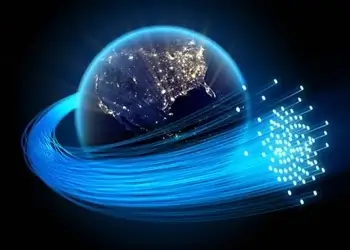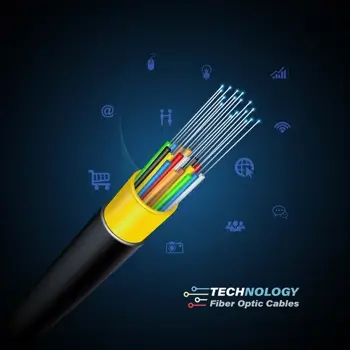What Is Fiber Optic Internet? How Fiber Optic Internet Works
As technology increases, our Internet options continue to expand. Each new method opens up more ways to connect at faster speeds through your Internet service provider, from dial-up to DSL to cable Internet connections. The most recent advancement in connections comes in the form of fiber optic Internet, a type of connection that relies on fiber optic cables to transfer signals at incredibly fast speeds. In this article, learn how fiber optic Internet connections work and why fiber optic might be the best choice for you.
What is fiber optic Internet?
As the name expresses, fiber optic Internet is a type of Internet relying on fiber optics. Fiber optics is the technology that transmits digitized information as light pulses through thin glass fibers. It encodes data in these pulses of light that travel thousands of miles, carrying phone calls, Internet data, and more.
Optical fiber technology, therefore, is the perfect option for transmitting large amounts of data at high speeds. It's available for use with data communication, telecommunications, and wide area network (WAN) systems thanks to its excellent data transfer capabilities, high bandwidth, and electrical isolation.
Because fiber optic cables must carry data over these great distances in the form of light rather than electricity, fiber optics cables are immune to electromagnetic interference, noise, and data loss. These assets make fiber optic networks one of the most prevalent forms of Internet connection today.
In telecommunications, fiber optics is steadily replacing traditional copper cables in longer-distance telephone lines. It also links computing devices within local area networks (LANs). Ultimately, it's becoming increasingly important as the demand for reliable data transmission grows.

How does fiber optic Internet work?
Optical fiber technology takes advantage of a phenomenon called total internal reflection. Fiber optics transmit data as pulses of light, or photons, through a fiber cable.
These cables, which consist of extremely thin optically-coated glass strands or fibers, are typically made up of three essential parts:
- The core, which is the center part of the fiber that carries and guides light signals. It's comprised of pure glass or plastic.
- The cladding, which is the outer layer of glass surrounding the core. It keeps the light inside the core by reflecting it inwards.
- The cable jacket, which is the outermost part of a fiber cable and offers protection against external forces.
Both the core and cladding have a property called refractive index, which measures how fast light travels through a medium. For fiber optics to work, the core must have a slightly higher refractive index than the cladding. When light particles travel through the cables, they hit the cladding at an angle and are ultimately reflected at the same angle.
The light signals then continue to bounce off the walls and undergo total internal reflection, which keeps them contained within the fiber.
Normally, fiber optics is designed to match the transmission speed of light, but it doesn't. This means light signals don't travel at the speed of light. They tend to travel about 30% slower due to dense glass layers.
To boost signals and avoid light scattering, optical data transmission lines need repeaters or amplifiers. These repeaters help convert the light signal into an electrical signal, which is then decoded to reveal the original information sent.
Types of optical fiber cables
Fiber optic cables carry more data than copper cables. It takes two copper wires to carry one telephone call; it takes two strands of optical glass fiber to translate the equivalent of 24,000 telephone calls. These fiber optic cables support most of the world's Internet, telephone, and television systems. However, there are two different kinds of optical fiber cables and, therefore, two different types of fiber optic Internet: single-mode fiber and multi-mode fiber.
Single-mode fiber (SMF)
Single-mode fibers feature narrow cores, around 8-10 microns in diameter, which support only one mode of transmission. The small diameter allows these fibers to carry light over greater distances while retaining the same force.
In SMF, all signals travel straight without bouncing. This type of fiber is used in long-haul communications systems like telephone, Internet, and cable TV signals. This kind of fiber also provides higher bandwidth.
Multi-mode fiber (MMF)
Multi-mode fiber, by comparison, has a large core diameter of around 50 to 62.5 microns. It allows multiple modes of light to propagate, resulting in more data transmission.
Each multi-mode fiber is around ten times bigger than single-mode fiber. However, this means there's a greater possibility of signal loss, interference, or reduction. MMF makes use of LEDs to create the light pulse. It works best with lower-speed applications, such as those found in LANs.
Why use fiber optic cables over copper cables?
Though copper cables worked as the traditional networking choice for years, optic cables have many advantages over copper cables.
- They offer higher bandwidth capacities.
- Unlike copper cables, fiber optic cables aren't prone to interference like EMI (electromagnetic interference) and RFI (radio frequency interference).
- Optical cables are more durable and lighter.
- Light travels over optical fibers without losing its strength.
- Fiber cables can go underwater.
- Optical fiber cables don't need replaced frequently and don't dissipate heat.
However, optical cables aren't perfect. Installing and replacing them is labor-intensive, and the cost of these cables is much higher than any other type of wiring. Furthermore, these cables are more fragile and thus require extra protection.
Even so, given the advantages of fiber optic cables in terms of transmission speed and efficiency, many opt to use them over traditional copper cables.
Benefits of fiber optic Internet
Fiber Internet is one of the fastest choices for Internet available today. If you want quick speeds and a reliable connection, consider the following advantages of fiber optic Internet.
- High speeds. Fiber cables have greater bandwidth which, in turn, delivers faster speeds to users.
- Consistent upload and download speeds. Unlike other types of Internet, fiber provides the same upload and download speeds. This helps those who rely on quick processing times for uploading and downloading files.
- Energy efficiency. Because fiber uses light rather than copper cables, they preserve environmental resources and can help larger companies save in energy costs.
- Flexibility. Fiber is a very scalable Internet option, making it ideal for companies or homes that add devices often.
- Improved latency. Fiber has a quick response time for Internet connections.
Fiber Internet is a great choice for those who need a reliable and fast connection. Though it does have some disadvantages - such as the fact that it's not yet available everywhere - it's a great option for most Internet users.

Uses of fiber optics
Fiber optics technology has many uses in day-to-day life. They include:
- Internet and cable television. Local Internet companies use fiber optic cables to provide high-speed Internet access, and many TV providers also use optical fiber to transmit information to televisions.
- Telecommunications. Fiber optics work well for transmission and reception, so in telecommunications networks, they are responsible for transmitting voice, data, and video signals.
- Computer networking and broadcasting. Fiber optics often connect computers, servers, and users in various network settings. Similarly, they allow broadcast networks to transmit video signals from studios to transmitters.
- Medical care. Originally, this technology developed to help doctors get scans without major surgery. Doctors use it today for MRI scans, endoscopies, surgical microscopies, x-ray imaging, and radiotherapy.
- Military defense. Military industries use optical fiber for signal transfer and a means of communication due to its high bandwidth capacities.
How do I get fiber optic Internet?
If fiber optic Internet infrastructure already exists in your area, you simply need to find a fiber optic Internet provider and switch your service over. Most cities and well-populated places have the infrastructure in place. Providers like AT&T, Comcast, and CenturyLink all offer this type of Internet to their customers. Check to see if it's available in your area.
If the infrastructure isn't already in place, then fiber optic Internet pricing will be significantly higher. You'll need to have the necessary equipment installed, which includes new cables and fiber jacks or network terminals. Contact your area's Internet service providers to see what options they have available for equipment and installation.
Frequently asked questions
Is fiber optic better than WiFi?
It depends on what qualities you're looking for.
Fiber optic Internet is superior in terms of speed and distance. The speed is constant, regardless of the number of connected devices or their bandwidth. The connection also isn't impacted by the distance between your device and the signal. WiFi signals are largely affected by both the number of devices on a network and the distance between a router and the device.
On the other hand, WiFi is significantly cheaper to install and maintain. It's also more convenient; wireless networks are portable and can almost guarantee connection of some kind. Fiber optic Internet is limited to a specific location.
In general, fiber optic is considered better in terms of connection, but each user can make the choice and decide for themselves.
What is the downside to fiber optic?
Though fiber optic Internet is the fastest Internet connection available on the market, its cost is the biggest downside. Installing and maintaining the necessary equipment can add up.
Does fiber optic Internet require electricity?
No, fiber optic Internet services don't rely on electricity.
What kind of light is used in fiber optics?
Fiber optics use infrared light.
Who invented fiber optics?
Professor Charles Keun Kao, an electrical engineer, is considered the father of fiber optic communications.
How is fiber optic Internet installed?
Fiber optic Internet is installed outside your home through a small utility box referred to as an optical network terminal. Cables run from equipment boxes to your terminal, which allows you access to the fiber optic Internet via an Ethernet cable connection.